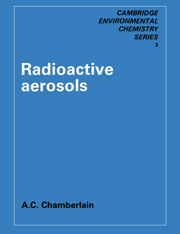Summary
Formation in fission and release to atmosphere
All the 24 isotopes of iodine with mass numbers 117 to 140 inclusive are formed in fission, either directly or by decay of a tellurium precursor. The fission chains including the four most important isotopes are shown in Fig. 3.1, with the percentage yields in slow neutron fission of 235U, as given by Crouch (1977). Somewhat higher yields of the iodine isotopes are found in fission of 235U, 238U and 239Pu by fast neutrons. Holland (1963) suggested that the fission yield of 131I in nuclear weapons should be taken as 4%, but UNSCEAR (1982) give a yield of 2.9% for weapons, which is almost the same as the yield in slow fission of 235U.
The activities of 131I per MW thermal power in reactors, and per kT explosion in weapons, using the UNSCEAR yields, are shown in Table 2.2. Iodine is volatile and its precursor tellurium is relatively volatile, especially when in an oxidised state. In nuclear explosions, particles are formed as the fireball cools, and the more volatile fission products condense on them (Section 2.3). The isotopes of iodine, mass numbers 131 to 134, are formed by decay of tellurium isotopes which condense in this way, so iodine is probably initially particulate, but may become desorbed. During a period of weapons testing in 1961, more than 70% of 131I in air at Harwell was particulate (Peirson & Keane, 1962). At Richland, Washington, Perkins (1963) found the gaseous fraction varying from 10 to 90%.
- Type
- Chapter
- Information
- Radioactive Aerosols , pp. 115 - 152Publisher: Cambridge University PressPrint publication year: 1991



